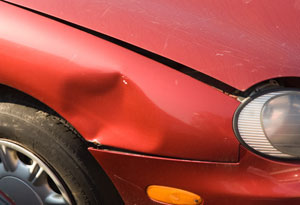What to Do After an Accident
Essential Tips for Parents and Teens

Photo: Thinkstock
Car accidents can happen so quickly, it might take you a couple of minutes to figure out just what happened. And anyone—not just teen drivers—can be so rattled right after a crash that it's easy to forget what to do. Experts advise printing a checklist like this one and keeping it in your glove compartment. You can save precious minutes by springing into action quickly rather than trying to order your thoughts.
1. Check to see if you or any of your passengers have been injured. Stay calm. Don't hesitate to call 911 if anyone needs medical help. Moving someone who's unconscious can make injuries worse, so don't do it unless you have to. If you must move someone who's injured because he or she is in a dangerous situation, make sure to keep the head and neck supported. 2. Get out of the way of traffic. Safely move your car to the side of the road or the safest area you can find that's out of the way of traffic. If your car isn't working, turn on your warning lights or pop your hood to warn other drivers.
3. Call the police. File a car accident report with the police when they arrive, even if it's a minor accident. Don't leave the scene until the full report is filed. And remember: Don't discuss the accident with anyone but the police and your insurance agent. Don't admit fault or liability, don't discuss what happened with passers-by, and get only the information you need from other people involved in the accident. Witnesses can be helpful, so feel free to ask bystanders if they'd be willing to give you their information in case you need someone to verify what happened.
4. Get the facts. Most people know to get information from other drivers and witnesses, but it's easy to forget exactly what information you need. It's helpful to write down a description of the car and a license plate number, but most insurance companies record a car's VIN number (or Vehicle Identification Number)—not the license plate—so get the number and the insurance company.
5. Take pictures. Sometimes there's no better witness than photographic evidence. Consider keeping a disposable camera in your glove compartment or trunk, or if you have a good camera on your cell phone, you can use it to photograph the scene. Take pictures of damage, skid marks and the location of the car accident (even street signs, or exit signs, so you'll remember where you were).
6. Draw a diagram. Were you at an intersection? On the highway? Who hit whom? If you can draw a quick diagram showing what happened, it can help preserve your memory of the accident and help the police in determining who was at fault.
7. Keep an accident kit. Consider assembling or buying a kit that you can use in case of an accident. An emergency kit can be useful in any situation; not just a crash. You'll want a disposable camera, and the following items: bottled water, first aid supplies, flashlight, blanket and jumper cables.
8. Schedule an appointment with your doctor. You might not even know you're injured; some whiplash and strain injuries might not even start hurting until well after you're home. It's always smart to call your doctor and get checked out.
9. Call your insurance agent. Call your agent or the toll-free number of your insurance company as soon as possible—even at the scene of the accident. If police are on the scene, ask the officer to speak with your insurance agent; sometimes they can give a more accurate report of the accident than you can if you're upset.
Prevent an accident today—sign Oprah's No Phone Zone pledge!



